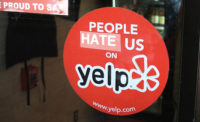In today’s media-saturated market, everyone has an opinion. And, for better or worse, consumers are chomping at the bit to share their viewpoints, especially following a less-than-favorable experience.
Numerous websites, including Yelp, Angie’s List, Google Reviews, Facebook, Houzz, etc., host consumer reviews on everything from local restaurants, recipes, dog groomers, and, yes, HVACR contractors. These published reviews provide guidance for potential prospects as they consider purchasing goods or services. And, it goes without saying, the lower the rating, the less chance a savvy shopper will buy.
“Millennials get their referrals from online reviews, so reviews will continue to be huge as the millennial population begins purchasing homes and HVAC systems,” said Travis Smith, president, Sky Heating & Air Conditioning, Portland, Oregon.
MAINTAINING THE POSITIVE
When considering hiring a service company, customers tend to turn to sites, such as Google, to review a company’s website and the experiences of others in similar situations. Most often, consumers will encounter one of two sorts of reviews: those that are very positive and those that are very negative. Whatever side of the spectrum, online reviews play a pivotal role in whether prospective customers opt to pay your bills or run to the hills toward your competitors.
“Sure, [online reviews] can make or break you,” said Rich Morgan, president, Magic Touch Mechanical Inc. “If you’re not putting out top-notch work and great customer service, enough people are going to legitimately write negative reviews, and you are going to lose business to your competitors who are. But if you are delivering great work and a high level of service, people are going to share that in positive reviews, if you ask, and enough of them will make the phones ring.”
It’s that quality service and work that will garner a higher rating on all of the review websites. But how do you get customers to speak on the positive and not just the negative?
“Ask for them,” said Chad Baumann, marketing manager, Baumann & DeGroot Heating & Cooling, Holland, Michigan. “If I am told over the phone or email how good an experience with us was, I usually ask them to share it on one of the platforms.”
Butch Welsch, owner of Welsch Heating & Cooling in St. Louis, goes out of his way to thank customers for positive reviews, which helps to create a lasting relationship.
“For any review that mentions positive things about an employee, we send them a written note from me, the owner, thanking them for acknowledging our employee or service.”
Similarly, Morgan also personally reaches out directly to customers, which has impacted his positive review ratings.
“As the owner, I personally respond to every review, positive or negative,” he said. “I have been told many times that our clients and prospective clients really like seeing the owner so involved. We try to collect a review at every service call with a text or email-based service that the technician sends to the homeowner while still at the home or business. We also have an application programming interface (API) on our website that we push people toward to leave a review.”
“Once, when I called a customer, she heard who I was and immediately said she was changing her review to five stars just because the owner called,” said Leland Smith, president, Service Champions Heating & Air Conditioning, Brea, California.
But how often are contractors checking their online reviews? Several have set up services so that they receive text or email alerts when a review is received, so they can quickly respond to thank a customer or address an issue.
“The typical review sites are all linked to my email, and I receive a notification whenever there is a new review posted,” said Baumann. “So, I check them as soon as I get the notification.”
“I try to check our online reviews monthly,” said Smith. “Most websites have a system that will alert you of any reviews, so you don’t have to actively check, and the reviews go directly to you so you can respond ASAP if needed.”
“Four people monitor our online reviews,” said Welsch. “It’s probably seldom that an hour goes by when one of the four doesn’t see a recent review.”
ADDRESSING THE NEGATIVE
While positive reviews are excellent, poor reviews are sometimes unavoidable. But it’s how you handle them that can put your business back in the good graces of disgruntled customers.
“We handle poor reviews quickly,” said Baumann. “I try not to paint with broad strokes with a one-size-fits-all reaction. After reviewing our notes and talking to the staff members who were involved in the complaint, I will contact the customer directly if we dropped the ball and provided a poor service experience. We tend to offer gift cards, discounts, or refunds in order to make things right; however, if the customer is out for blood, I will then respond firmly with facts to the complaint. I’ll then recommend they find a new service company.”
For Smith, there is a process that the company sticks by in order to remedy negative reviews.
“Myself and the marketing director originally would respond,” said Smith. “We would get a negative Yelp review and be paged. Our goal was within one hour to know what happened, plan on what we were going to do to fix our problem, and then address the customer’s issue. Then, we would plan the ‘wow.’ The wow was a commitment to the customer after we know we’d made the customer happy and all was done. This could be a free repair, but most of the time it was a $200 gift card to say ‘thank you’ for letting us know of our mistake and allowing us to address it with our team to make us all better.”
Bad reviews happen, but there is also the downside – anybody can leave a comment, including those with venomous intentions. Internet trolls are a thing of the 21st century, and they are everywhere. Someone may be looking for an easy way to get their services paid for – even if it means bashing the HVAC company in a Google review. So, how does one know how to address these customers and unpredictable situations?
“It seems about half of the bad reviews are from bad customers that we either turned down working for, sent to collections, or had general issues with,” said Smith. “The first thing we do is respond to tell our side of the story. One that sticks out recently was a customer who claimed we forced him to replace his heat pump and then did not take care of the broken system under warranty. First, the heat pump was backed into by a car and was only 12 inches wide and beyond repair, and second, the warranty call he claimed we charged him for was three years after the install on a zoning system we didn’t install. So, we quickly responded with the facts and a picture of the broken heat pump so that anyone reading the review would realize this individual was a bit crazy.”
Welsch also treads lightly when it comes to handling negative online reviews. Recently, Welsch had a customer who wanted a technician to make unethical and dishonest decisions on the job. When a technician refused, the customer left a negative review with the Better Business Bureau (BBB).
“We feel we were set up,” he said. “A potential, new customer, who we had never serviced before, called us out online. The person calling was the building owner, and it was a tenant’s a/c that was apparently not working. The person who called wanted our service technician to crawl through the tenant’s window and then up into the attic and back out through another window to get to the roof where the a/c was located. Then, since she anticipated the unit was low on Freon, she wanted us to put her Freon from a jug she provided into the unit. Then, at the end, she wanted us to be untruthful on the service ticket for the tenant to sign. Our technician refused to do the work, and our office supported him on the fact that he was being requested to take unethical and dishonest actions. Nevertheless, the lady wrote a very nasty review to the BBB about our company. We merely responded by saying, ‘We are very sorry you were not happy with the service provided.’”
While negative reviews can sting, it’s important not to take every one to heart. Negative reviews can often times be circumstantial and a result of a customer being difficult. Also, 100 percent five-star reviews can also signal to a customer that the reviewers aren’t being genuine or work for the company to submit comments. A few poor reviews here and there mixed in with the positive demonstrate to customers a company’s legitimacy.
“I used to take negative reviews very personally,” said Steve Moon, president, Moon Services Inc., Elkton, Maryland. “I’ve found certain sites that seem to be filled with haters that you could not make happy even if you paid them. We make a very high percentage of our clients happy, but having all five-star reviews makes it look like you put them all up yourself. A bad one here or there kind of adds to your credibility. The best you can do is to collect as many positive reviews as possible and let the reviews fall where they may.”
And, sometimes, companies have to consider divorcing a customer. While nobody likes to turn down business, some customers simply cannot be pleased, and owners must recognize when it’s time to throw in the towel.
“As soon as you realize you can’t make them happy, it’s time to be done with them,” said Smith. “Some customers just want to complain and be miserable. There is someone else out there who will take them on. We have plenty of good work, so why waste our time with bad customers who only want to bring our business down?”
Morgan agrees that eliminating a customer is never easy, but it’s necessary when one’s actions threaten your business.
“Every situation is different,” he said. “I would never divorce a customer with legitimate complaints, in fact, I would bend over backwards to make things right, even if the customer was going to be ‘lost’ at the end of it all. When a customer starts using threats of bad reviews as an extortion method, that’s when I file for a divorce.”
For Baumann, a good indicator of when it’s time to call it quits is when a customer is attempting to bargain for a free service.
“We can quickly ascertain when a customer is just out for something for nothing or who is a well-intentioned customer who we have done wrong. A great filter for these customers is asking the question, ‘What would you like to see to make this right?’ If the first words out of their mouths are, ‘I don’t think I should have to pay for this,’ then that’s a clear indicator of their negative intentions. We offer a service for a price. We can find wiggle room in our bills if we screwed up, but if people expect us to waive all of the charges, those are the ones we don’t want back. We will generally honor their request and ask them to find a new service company.”
Whether the HVAC company is a huge conglomerate or a mom and pop shop down the street, chances they’ve been reviewed online.
And, when these reviews surface, it’s the owner’s job to know how to handle the good, the bad, and the ugly.
Publication date: 9/11/2017
Want more HVAC industry news and information? Join The NEWS on Facebook, Twitter, and LinkedIn today!











